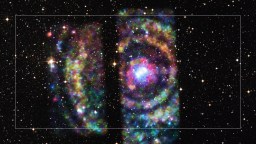Trash on earth is pretty bad. But space trash is at a whole other level. Imagine how much damage just a single screw can make when it’s hurtling right at you at 17,500mph. You can follow Michelle Thaller on Twitter at @mlthaller.
Michelle Thaller: Hey Eve, this is a great question because this actually really is a big problem in space exploration: all of the different junk that’s up there. It’s actually the 16th anniversary of the first satellite the United States ever sent up called Explorer 1.
So for more than 60 years the earth has been putting up satellites and robots and space stations and all kinds of stuff up into orbit, and a lot of junk has accumulated. And sometimes it’s just very small; in the early days of space exploration sometimes they would even paint satellites and all of those little paint chips—as things actually degraded in space, it’s very cold, it’s very dry up there—after decades in space the paint all chipped off and now there are these tiny little things flying around in orbit. But the problem is is that if you’re in low Earth orbit, by definition you’re traveling at about 17,000 miles an hour. That’s much, much, much faster than a bullet comes out of a gun. So even a tiny little thing going at that speed, if it hits you in the wrong direction it can cause huge amounts of damage.
And in fact one of the things that we do is actually study all the debris up there and all the collisions. There’s parts of the Hubble Space Telescope that the astronauts have actually brought back to earth, and we actually look at the metal and the surfaces and think about all of the little things that have hit we study how much damage there is from all of the debris up there. Some of the debris is caused by humans—you know, bits of old spacecraft—and some of it is actually natural: there’s just particles of dust up there. This is what creates meteors or what people know as shooting stars. The earth accumulates about a hundred tons every day of natural rock and sandy stuff from space falling down on us. So some of the junk up there isn’t even human caused, it’s actually even natural.
So what do you do with this environment up there that’s full of tiny little things? In some cases we actually worry about the astronauts being hit by these. So if there’s an astronaut out doing his spacewalk, they’re in a pressurized space suit and just like you can’t really make a tiny little hole in a balloon, if something actually got through the space suit under pressure that would be incredibly dangerous for the astronaut. So there are many things up there that we track.
We’re actually so aware that space junk is becoming more and more of a problem that we’re really encouraging other countries to be careful about what they do up in space. A couple of years ago China, as an experiment, actually collided two of their satellites. It was sort of a military and space experiment, and the amount of space junk went up almost exponentially from that. From that one single event—these two satellites colliding—all of this different stuff went off into space. So some people have a job at NASA to actually track the larger bits of space junk. And in some cases we know exactly where they are and we can actually get our satellites out of the way of them. Even the International Space Station has the ability to change its orbit just a little bit and actually maneuver.
So if there’s a particularly large piece of space junk the space station may choose to make little maneuvers to avoid it. A few times astronauts have actually been a little bit worried there’s been a tiny, tiny chance of a collision: only a couple percent, but that’s enough for us to be concerned for them. And in some cases we’ve asked them to get ready for an evacuation in case anything happened, but luckily nothing ever did.
So NASA is very aware of the space junk problem. The question is what do you do about it?
Because think about this, when you’re up in orbit above the earth you’re talking about an area that’s actually larger than the entire surface of the earth. And you’re not only talking about an area that extends up from the surface of the earth, but it extends up for hundreds of miles. Space junk is at many different altitudes. So there really isn’t any way to take a giant vacuum cleaner and just start going after piece by piece of space junk. You would never cover that amount of volume. It would take you centuries to even try. So people are talking about ideas, like could you take lasers, could you maybe actually vaporize some of the space dust? How would you clean it up? Could you actually unfurl big sails that would sail around the earth and scoop up some of the space junk? Maybe.
But I for now haven’t seen a particularly good solution. The best solution is to try to put as little of that stuff into orbit as possible and know where the bigger pieces are. And right now we really have to manage the problem more than solve it.






